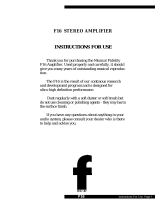
PLD Series Amplifiers 3
Application Guide—Production Rev. B May 2015
Table of Contents
1. Introduction ...................................................................................................................................................................................................... 5
Why PLD? ...................................................................................................................................................................................................................................................5
PLD: A new paradigm .............................................................................................................................................................................................................................. 6
Electrical power .......................................................................................................................................................................................................................................9
FAST (Flexible Amplifier Summing Technology™) .......................................................................................................................................................................... 12
Amplifier Navigator™............................................................................................................................................................................................................................15
Presets .....................................................................................................................................................................................................................................................16
2. Real-World Applications with PLD ................................................................................................................................................................ 20
Loudspeaker power capacities ...........................................................................................................................................................................................................20
Production examples ............................................................................................................................................................................................................................20
Application: 16 monitor mixes ............................................................................................................................................................................................................. 21
Application: 12 monitor mixes with eight front fills ........................................................................................................................................................................22
Application: 12 monitor mixes, combination of passive and bi-amp ...........................................................................................................................................23
Application: Eight bi-amp monitor mixes .......................................................................................................................................................................................... 24
Application: Eight monitor mixes, combination of passive and bi-amp ..................................................................................................................................... 25
Application: Four monitor mixes ......................................................................................................................................................................................................... 26
Application: Left/right ground stack system ..................................................................................................................................................................................... 27
Application: Left/right ground stack system ..................................................................................................................................................................................... 28
Application: Single line array hang ....................................................................................................................................................................................................29
Application: Single line array hang ....................................................................................................................................................................................................30
Application: Single line array hang ....................................................................................................................................................................................................31
Application: Single line array hang ....................................................................................................................................................................................................32
Application: Left/right line array hangs ............................................................................................................................................................................................. 33
Application: Left/right line array hangs with subwoofers .............................................................................................................................................................35
Application: Left/right line array hangs with subwoofers .............................................................................................................................................................36
Application: Left/center/right line array hangs with subwoofers ................................................................................................................................................37
Application: High-power subwoofers with front fills .....................................................................................................................................................................39
Application: High-power subwoofers ................................................................................................................................................................................................40
3. PLD Series Specifications ................................................................................................................................................................................41






















